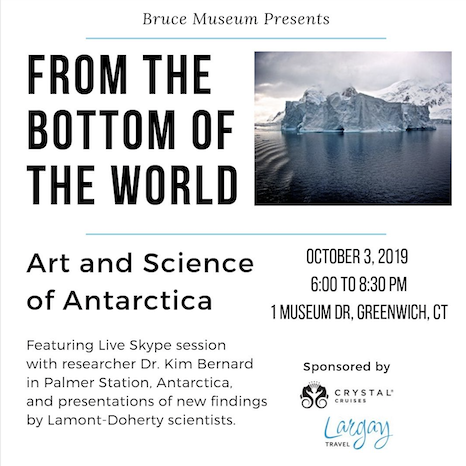
GREENWICH, CT — Antarctica is the planet’s true final frontier. Presented in cooperation with Columbia University’s Lamont-Doherty Earth Observatory as part of the Bruce Museum Presents series of monthly public programs, From the Bottom of the World: The Art and Science of Antarctica will convene peerless experts in the art and science of this unique and fragile continent. Two research scientists from Lamont-Doherty, Jonny Kingslake and Kirsty Tinto, will reveal their startling new findings about the ice and changing climate.
Live via Skype – the Bruce Museum welcomes Dr. Kim S. Bernard, associate professor of biological oceanography at Oregon State University, currently based at Palmer Station in Antarctica. During a 15-minute live interview, Dr. Bernard will answer questions from the audience about her research and her experience on the ice. Dr. Bernard is a biological oceanographer whose research focuses on the role that zooplankton play in pelagic food webs and biogeochemical cycles.
Central to her research is the fundamental question – How will climate change alter zooplankton ecology, and thus the structure and function of pelagic ecosystems and services? Dr. Bernard’s research is empirical and hypothesis-driven, and she makes use primarily of quantitative data collected in the field, often during extended deployments or lengthy research cruises.
Dr. Bernard was recently awarded a prestigious National Science Foundation Early Career grant to conduct research on Antarctic krill during the winter. She is nearing the end of her first 6-month winter expedition to Palmer Station, though she has spent a total of 24 months there over five summers in the past. During this time, Dr. Bernard has witnessed new islands appearing as the glacier has retreated and the devastating crash of the local Adélie penguin population.
Jonny Kingslake is an Assistant Professor at Lamont-Doherty Earth Observatory, Columbia University. His research focuses on the flow of ice and water in ice sheets. He has conducted fieldwork in Norway, Alaska, Greenland, and Antarctica, using a combination of mathematical models, satellite data, and field observations to examine fascinating and important processes that control how the ice sheets will respond to climate change.
The goal of his Antarctic fieldwork was to measure how the ice sheet flows today and how this has changed over the last few thousand years. This involved spending a total of four months camping on and traversing the Weddell Sea Sector of Antarctica using ice-penetrating radar to measure the internal structure of the ice. He will talk about this project and Antarctica more generally, show photos and movies from the fieldwork, and briefly show some exciting results that reveal how the ice sheet has changed over the past 10,000 years.
Kirsty Tinto is an Associate Research Scientist at the Lamont-Doherty Earth Observatory whose research focuses on how the underlying geology controls the flow of ice sheets in Greenland and Antarctica. She has extensive polar field experience, both from the ground and using geophysical instruments mounted on long-range aircraft. Through NASA’s Operation IceBridge and the National Science Foundation IcePod projects, she has participated in more than a dozen airborne field campaigns to polar regions, and led the recent ROSETTA-Ice project, mapping the Ross Ice Shelf in Antarctica. She holds a Masters of Earth Science from Oxford University, UK, and a PhD in Geophysics from the University of Otago, NZ.
Leonard Jacobs, former Director of Cultural Institutions at the New York City Department of Cultural Affairs, produces the series and will moderate this timely conversation.
Suzanne Lio, Managing Director of the Bruce Museum, conceived Bruce Museum Presents. “We have long been an important resource in our community for forward-thinking public programs,” Lio notes. “This series raises it to the next level. By leveraging our unique network of institutional and professional connections, the series will offer unprecedented access for our members and visitors to major thought leaders in the fields of art and science.”
Doors open 6:00 pm for a reception with light bites and beverages, followed by the panel discussion, Skype session, and Q&A, 7:00-8:30 pm. Seats are $30 for Museum members, $45 for non-members. To reserve a seat at The Art and Science of Antarctica, visit brucemuseum.org or call 203-869-0376.
Bruce Museum Presents is supported by the Connecticut Office of the Arts. Special thanks to Paulaner USA for supporting our public programs and special events. The evening’s sponsors are Crystal Cruises and Largay Travel, which specialize in expedition voyages. The Bruce is grateful to the National Science Foundation’s Office of Polar Programs for their assistance in arranging this extraordinary opportunity to hear directly from an on-the-ground expert on the state of the ocean at the bottom of the world.